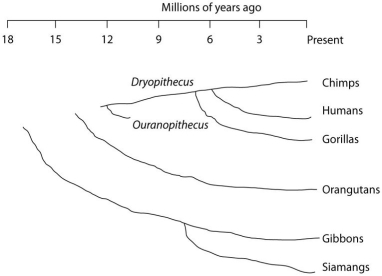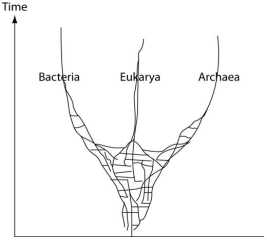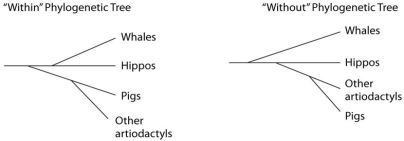A) Among themselves, they should share relatively few ancestral traits, especially those that enabled ancestral forms to adapt to extreme conditions.
B) On a phylogenetic tree whose branch lengths are proportional to the amount of genetic change, the branches of the extremophiles should be shorter than the non-extremophilic archaeans.
C) They should contain genes that originated in eukaryotes that are the hosts for numerous species of bacteria.
D) They should currently be undergoing a high level of horizontal gene transfer with non-extremophilic archaeans.
Correct Answer

verified
Correct Answer
verified
Multiple Choice
When using a cladistic approach to systematics, which of the following is considered most important for classification?
A) shared primitive characters
B) analogous primitive characters
C) shared derived characters
D) the number of homoplasies
E) overall phenotypic similarity
Correct Answer

verified
Correct Answer
verified
Multiple Choice
The common ancestors of birds and mammals were very early (stem) reptiles, which almost certainly possessed three-chambered hearts (two atria, one ventricle) . Birds and mammals, however, are alike in having four-chambered hearts (two atria, two ventricles) . The? four-chambered hearts of birds and mammals are best described as
A) structural homologies.
B) vestiges.
C) homoplasies.
D) the result of shared ancestry.
E) molecular homologies.
Correct Answer

verified
Correct Answer
verified
Multiple Choice
Which eukaryotic kingdom includes members that are the result of endosymbioses that included an ancient proteobacterium and an ancient cyanobacterium?
A) Plantae
B) Fungi
C) Animalia
D) Protista
E) Monera
Correct Answer

verified
Correct Answer
verified
Multiple Choice
Use the following figure to answer the questions below.
 Humans, chimpanzees, gorillas, and orangutans are members of a clade called the great apes, which shared a common ancestor about 18 million years ago. Gibbons and siamangs comprise a clade called the lesser apes. Tree-branch lengths indicate elapsed time.
-The great apes comprise the family Hominidae, whereas the lesser apes comprise the family Hylobatidae. If the extant organisms on the far right side of the above figure comprise the next-most exclusive (i.e., specific) taxon, then they comprise different
Humans, chimpanzees, gorillas, and orangutans are members of a clade called the great apes, which shared a common ancestor about 18 million years ago. Gibbons and siamangs comprise a clade called the lesser apes. Tree-branch lengths indicate elapsed time.
-The great apes comprise the family Hominidae, whereas the lesser apes comprise the family Hylobatidae. If the extant organisms on the far right side of the above figure comprise the next-most exclusive (i.e., specific) taxon, then they comprise different
A) subspecies.
B) species.
C) genuses.
D) genera.
E) orders.
Correct Answer

verified
Correct Answer
verified
Multiple Choice
Which of the following is true of all horizontally oriented phylogenetic trees, where time advances to the right?
A) Each branch point represents a point in absolute time.
B) Organisms represented at the base of such trees are descendants of those represented at higher levels.
C) The fewer branch points that occur between two taxa, the more divergent their DNA sequences should be.
D) The common ancestor represented by the rightmost branch point existed more recently in time than the common ancestors represented at branch points located to the left.
E) The more branch points there are, the fewer taxa are likely to be represented.
Correct Answer

verified
Correct Answer
verified
Multiple Choice
Concerning growth in genome size over evolutionary time, which of these is least associated with the others?
A) orthologous genes
B) gene duplications
C) paralogous genes
D) gene families
Correct Answer

verified
Correct Answer
verified
Multiple Choice
In a comparison of birds and mammals, having four limbs is
A) a shared ancestral character.
B) a shared derived character.
C) a character useful for distinguishing birds from mammals.
D) an example of analogy rather than homology.
E) a character useful for sorting bird species.
Correct Answer

verified
Correct Answer
verified
Multiple Choice
Which kingdom has been replaced with two domains?
A) Plantae
B) Fungi
C) Animalia
D) Protista
E) Monera
Correct Answer

verified
Correct Answer
verified
Multiple Choice
The following questions refer to this phylogenetic tree, depicting the origins of life and of the three domains. Horizontal lines indicate instances of gene or genome transfer.
 A possible phylogenetic tree for the three domains of life.
-Which portion of the above figure may ultimately be better depicted as a "ring"?
A possible phylogenetic tree for the three domains of life.
-Which portion of the above figure may ultimately be better depicted as a "ring"?
A) the bacterial lineage
B) the archaean lineage
C) the eukaryotic lineage
D) the trunk of the tree
E) the part corresponding to the first living cell on Earth
Correct Answer

verified
Correct Answer
verified
Multiple Choice
Some molecular data place the giant panda in the bear family (Ursidae) but place the lesser panda in the raccoon family (Procyonidae) . Consequently, the morphological similarities of these two species are probably due to
A) inheritance of acquired characteristics.
B) sexual selection.
C) inheritance of shared derived characters.
D) possession of analogous structures.
E) possession of shared primitive characters.
Correct Answer

verified
Correct Answer
verified
Multiple Choice
There is some evidence that reptiles called cynodonts may have had whisker-like hairs around their mouths. If true, then what can be properly said of hair?
A) It is a shared derived character of mammals, even if cynodonts continue to be classified as reptiles.
B) It is a shared derived character of the amniote clade, and not of the mammal clade.
C) It is a shared ancestral character of the amniote clade, but only if cynodonts are reclassified as mammals.
D) It is a shared derived character of the mammals, but only if cynodonts are reclassified as mammals.
Correct Answer

verified
Correct Answer
verified
Multiple Choice
If, someday, an archaean cell is discovered whose rRNA sequence is more similar to that of humans than the sequence of mouse rRNA is to that of humans, the best explanation for this apparent discrepancy would be
A) homology.
B) homoplasy.
C) common ancestry.
D) retro-evolution by humans.
E) coevolution of humans and that archaean.
Correct Answer

verified
Correct Answer
verified
Multiple Choice
Assuming chimps and gorillas are humans' closest relatives, removing humans from the great ape clade and placing them in a different clade has the effect of making the phylogenetic tree of the great apes
A) polyphyletic.
B) paraphyletic.
C) monophyletic.
D) conform with Linnaeus' view of great ape phylogeny.
Correct Answer

verified
Correct Answer
verified
Multiple Choice
Which kind of DNA should provide the best molecular clock for determining the evolutionary relatedness of several species whose common ancestor became extinct billions of years ago?
A) that coding for ribosomal RNA
B) intronic DNA belonging to a gene whose product performs a crucial function
C) paralogous DNA that has lost its function (i.e., no longer codes for functional gene product)
D) mitochondrial DNA
E) exonic DNA that codes for a noncrucial part of a polypeptide
Correct Answer

verified
Correct Answer
verified
Multiple Choice
The domestic dog, red fox, and wolf belong to the family Canidae. The dog is Canis lupus familiaris, the red fox is Vulpes vulpes, and the wolf is Canis lupus. Which of the following statements is correct?
A) All three canids are in different genera.
B) The red fox is in the same family, but of a different genus, than wolves and dogs.
C) All three canids should successfully breed with one another.
D) All three belong to the same genera but are different species.
E) All three canids live on different continents.
Correct Answer

verified
Correct Answer
verified
Multiple Choice
If you were using cladistics to build a phylogenetic tree of cats, which of the following would be the best outgroup?
A) lion
B) domestic cat
C) wolf
D) leopard
E) tiger
Correct Answer

verified
Correct Answer
verified
Multiple Choice
Which statement represents the best explanation for the observation that the nuclear DNA of wolves and domestic dogs has a very high degree of sequence homology?
A) Dogs and wolves have very similar morphologies.
B) Dogs and wolves belong to the same order.
C) Dogs and wolves are both members of the order Carnivora.
D) Dogs and wolves shared a common ancestor very recently.
Correct Answer

verified
Correct Answer
verified
Multiple Choice
Use the following information and figure to answer the questions below.
Traditionally, whales and hippopotamuses have been classified in different orders, the Cetacea and the Artiodactyla, respectively. Recent molecular evidence, however, indicates that the whales' closest living relatives are the hippos. This has caused some zoologists to lump the two orders together into a single clade, the Cetartiodactyla. There is no consensus on whether the Cetartiodactyla should be accorded order status or superorder status. This is because it remains unclear whether the whale lineage diverged from the lineage leading to the hippos before or after the other members of the order Artiodactyla (pigs, camels, etc.) diverged (see the figure below) .
 This figure contrasts the "Within the artiodactyls" origin of the whale lineage with the "Without the artiodactyls" origin of the whale lineage.
-One morphological feature of modern cetaceans is a vestigial pelvic girdle. If it is determined that cetacean lineage diverged from the artiodactyls' lineage after the divergence of pigs and other artiodactyla, then what should be true of the vestigial pelvic girdle of cetaceans?
This figure contrasts the "Within the artiodactyls" origin of the whale lineage with the "Without the artiodactyls" origin of the whale lineage.
-One morphological feature of modern cetaceans is a vestigial pelvic girdle. If it is determined that cetacean lineage diverged from the artiodactyls' lineage after the divergence of pigs and other artiodactyla, then what should be true of the vestigial pelvic girdle of cetaceans?
A) It should be considered a shared ancestral character of the cetartiodactyls.
B) It should be considered a shared derived character of the cetartiodactyls.
C) It should be considered a shared ancestral character of the cetaceans.
D) It should be considered a shared derived character of the cetaceans.
Correct Answer

verified
Correct Answer
verified
Multiple Choice
Use the following information and figure to answer the questions below.
Traditionally, whales and hippopotamuses have been classified in different orders, the Cetacea and the Artiodactyla, respectively. Recent molecular evidence, however, indicates that the whales' closest living relatives are the hippos. This has caused some zoologists to lump the two orders together into a single clade, the Cetartiodactyla. There is no consensus on whether the Cetartiodactyla should be accorded order status or superorder status. This is because it remains unclear whether the whale lineage diverged from the lineage leading to the hippos before or after the other members of the order Artiodactyla (pigs, camels, etc.) diverged (see the figure below) .
 This figure contrasts the "Within the artiodactyls" origin of the whale lineage with the "Without the artiodactyls" origin of the whale lineage.
-Placing whales and hippos in the same clade means
This figure contrasts the "Within the artiodactyls" origin of the whale lineage with the "Without the artiodactyls" origin of the whale lineage.
-Placing whales and hippos in the same clade means
A) that these organisms are phenotypically more similar to each other than to any others shown on the trees in the above figure.
B) that their morphological similarities are probably homoplasies.
C) that they had a common ancestor.
D) that all three of the responses are correct.
E) that two of the responses are correct.
Correct Answer

verified
Correct Answer
verified
Showing 41 - 60 of 81
Related Exams